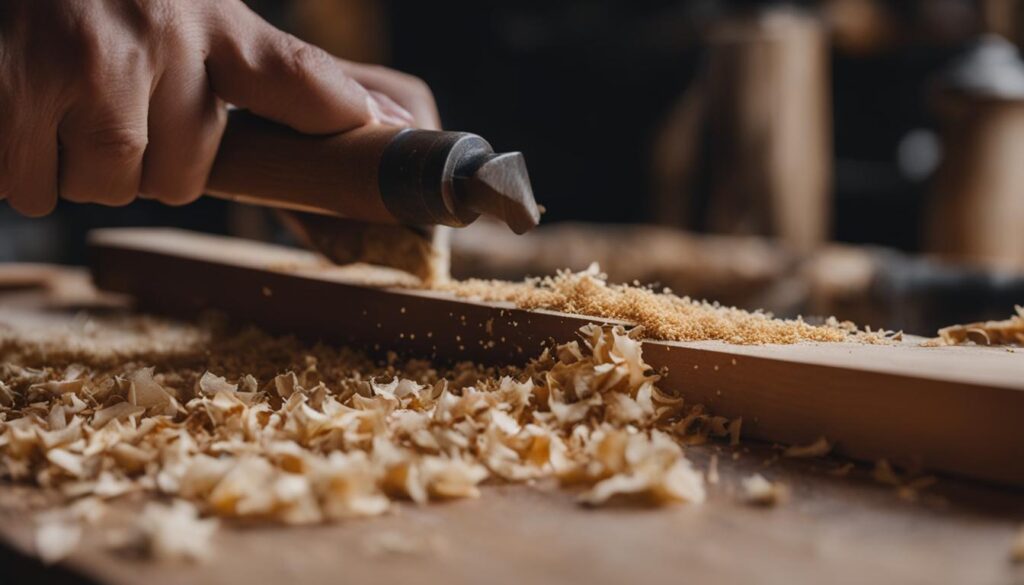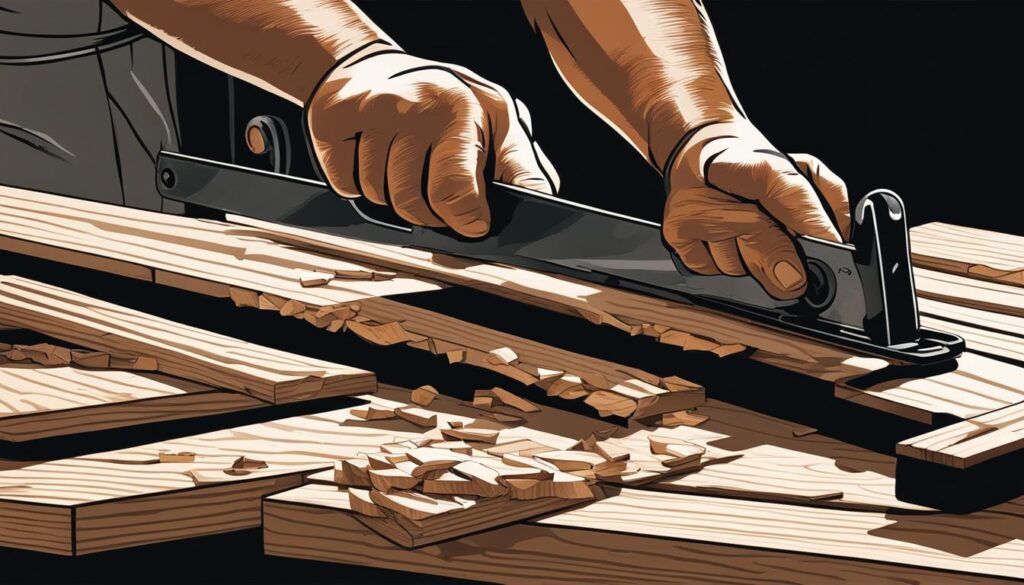We may earn money or products from the companies mentioned in this post.
If you are passionate about woodworking, you know that perfect joinery is essential to create high-quality, visually appealing, and long-lasting pieces. Joinery methods are the foundation of woodworking, and mastering them is crucial to developing your skills as a woodworker. In this ultimate guide, we will provide you with tips, techniques, and step-by-step tutorials to help you achieve perfect joinery in your woodworking projects.
In this section, we will introduce you to woodworking joinery methods. You will learn about different joinery techniques and the various types of woodworking joints. This section is essential for both beginners and experienced woodworkers, as it covers the basics of joinery and provides valuable insights to enhance your skills.
Key Takeaways:
- Woodworking joinery methods are crucial to achieving high-quality, visually appealing, and long-lasting woodworking pieces.
- Joinery techniques are the foundation of woodworking.
- This section covers the basics of joinery and provides valuable insights to enhance your skills.
Traditional Joinery Techniques
In woodworking, joining pieces of wood together is a fundamental skill that has been practiced for centuries. Traditional joinery techniques have been passed down from generation to generation and are still widely used, even with the advent of powerful modern tools and innovative techniques.
Woodworking techniques involve a variety of types of joinery, which include butt joints, dovetail joints, mortise and tenon joints, and more. Traditional joinery methods tend to rely on hand tools like chisels, saws, and hand planes that provide woodworkers with more control and precision.
| Joining Method | Description | Tools Used |
|---|---|---|
| Butt Joint | A simple joint that involves joining the end of one board to the face of another. It is fast, easy, and can be strengthened with glue or nails. | Saw, chisel, hammer, measuring tools |
| Dovetail Joint | A strong joint that involves cutting trapezoidal pins on one board that fit into corresponding tails in another board. It is widely used in furniture making. | Chisels, saws, coping saw, marking gauge, mallet |
| Mortise and Tenon Joint | A versatile joint that involves a protruding tenon on one board that fits into a matching hole or mortise on another board. It is commonly used in door and window frames, furniture making, and other woodworking projects. | Chisels, saws, marking gauge, mallet |
Mastering traditional joinery techniques requires time, patience, and practice. Woodworkers must have a deep understanding of the properties of different types of wood, as well as the right tools and techniques for each joining method. With practice and skill, traditional joinery techniques can produce pieces of woodworking that are both beautiful and strong.
Modern Joinery Methods
Woodworking has come a long way from the time-tested techniques of traditional joinery. Advancements in technology and modern joinery tools have paved the way for innovative methods that not only enhance the strength and durability of joints but also add aesthetic appeal to woodworking projects.
Modern joinery methods use precision technology and specialized tools to create clean and accurate joints that fit together seamlessly. One such technology is CNC (Computer Numerical Control) machines, which can be programmed to cut wood precisely to fit together perfectly. Another modern technique is the use of adhesives such as polyurethane glue, which can create a bond that is even stronger than the wood itself.
Joinery Tools
Modern joinery tools are designed to make woodworking easier, faster, and more accurate. Some of the most popular tools used in modern joinery include:
| Tool | Description |
|---|---|
| Router | A tool used to hollow out an area in a piece of wood to create a joint. |
| Biscuit Joiner | A tool that creates a slot in two pieces of wood, which is then filled with a wooden biscuit that creates a strong joint. |
| Dovetail Jig | A tool used to cut dovetail joints with precision and speed. |
Woodworking Techniques
Some of the most popular modern joinery techniques include:
- Floating tenon joinery: This technique creates a strong joint by inserting a small piece of wood (the tenon) into a slot in both pieces of wood to be joined. The tenon is then secured with glue.
- Dowel joinery: This technique uses small wooden dowels to connect two pieces of wood. The dowels are glued into pre-drilled holes, creating a strong joint.
- Mitered butt joint: This technique is used to create a clean and simple joint on the corners of a box or frame. The two pieces of wood are cut at a 45-degree angle, and the cut ends fit together tightly.
Modern joinery techniques offer endless possibilities for woodworkers who want to create unique and visually appealing pieces. By combining traditional and modern joinery methods, woodworkers can create strong and durable joints that also enhance the aesthetic appeal of their projects.
Step-by-Step Tutorials for Perfect Joinery
Joinery projects require precision and attention to detail. With the right joinery tips and woodworking techniques, you can achieve perfect joinery in your woodworking projects. Here are some step-by-step tutorials for some common joinery techniques:
Dovetail Joint:
The dovetail joint is a classic woodworking joint used in cabinetry, drawers, and boxes. It is known for its strength and durability. Follow these steps to create a dovetail joint:
- Mark out the pins and tails on each end of the boards
- Cut out the tails using a saw and chisel
- Mark out the pins by transferring the tail marks onto the other board
- Cut out the pins using a dovetail saw and chisel
- Fit the pins and tails together and adjust for a snug fit
- Glue and clamp the joint together
Mortise and Tenon Joint:
The mortise and tenon joint is another classic joint used in furniture, cabinetry, and door frames. It is a strong joint that can withstand a lot of weight and stress. Follow these steps to create a mortise and tenon joint:
- Cut the tenon on the end of one board
- Mark out the mortise using a marking gauge
- Drill a hole at each end of the mortise
- Chisel out the mortise to fit the tenon
- Fit the tenon into the mortise and adjust for a snug fit
- Glue and clamp the joint together
Biscuit Joint:
A biscuit joint is a simple and effective way to join two pieces of wood. It is commonly used in paneling and tabletops. Here are the steps to create a biscuit joint:
- Mark out the biscuit location on each board
- Use a biscuit joiner to cut the slots in each board
- Insert the biscuits and add glue to the slots
- Align the boards and clamp them together
- Allow the glue to dry and sand the excess glue off
These step-by-step tutorials are just a few examples of the many joinery techniques you can use in your woodworking projects. By mastering these joinery methods, you can ensure strong and precise connections in your woodworking projects.
Conclusion
Woodworking joinery methods are fundamental to creating functional and aesthetically pleasing woodworking projects. With the help of this ultimate guide, you can master traditional joinery techniques and explore modern joinery methods to enhance your woodworking skills. By understanding the necessary tools and following step-by-step tutorials, you can create perfect joinery connections every time.
Joinery techniques play a pivotal role in woodworking, and learning about them is an ongoing process. Continuously practicing these techniques and experimenting with different joinery projects will only improve your skills and produce better results.
Whether you are a beginner or an experienced woodworker, this guide provides comprehensive information on woodworking joinery methods. It emphasizes the importance of understanding various joinery techniques, the tools required, and the step-by-step tutorials needed to achieve perfect joinery.
Take the time to practice and master these joinery techniques, and you will see your woodworking skills improve significantly. It’s time to enhance your woodworking craftsmanship with these essential woodworking joinery methods and joinery techniques.
FAQ
What are woodworking joinery methods?
Woodworking joinery methods refer to the techniques and methods used to join different pieces of wood together to create strong and stable connections. These methods include various types of joints and joinery techniques.
What are woodworking joints?
Woodworking joints are specific types of connections between pieces of wood. They are designed to provide strength, stability, and aesthetic appeal to woodworking projects. Some common woodworking joints include dovetail joints, mortise and tenon joints, and tongue and groove joints.
How can I improve my joinery skills?
Improving your joinery skills requires practice and knowledge of different joinery techniques. Start by understanding the characteristics and applications of various woodworking joints. Familiarize yourself with the necessary tools and equipment for joinery. Finally, practice joinery techniques through guided tutorials and projects.
What tools do I need for woodworking joinery?
The tools needed for woodworking joinery vary depending on the specific technique and joint being used. Some common tools include chisels, saws, routers, drill presses, and measuring tools. It is important to have quality tools and keep them sharp to achieve precise joinery connections.
Can joinery techniques be used for different woodworking projects?
Yes, joinery techniques can be used for a wide range of woodworking projects. From furniture construction to cabinetry and smaller craft projects, the right joinery techniques can provide structural integrity and enhance the overall appearance of your creations.
Are there any safety considerations when working with joinery techniques?
Yes, safety should always be a priority when working with woodworking joinery techniques. Wear appropriate protective gear, such as safety glasses and gloves. Use tools and equipment properly, following manufacturer instructions. Take caution when handling sharp tools and working with power tools. Always keep your work area clean and organized to prevent accidents.
Where can I find step-by-step tutorials for joinery projects?
Step-by-step tutorials for joinery projects can be found in woodworking books, online woodworking communities, and tutorial websites. You can also consider taking woodworking classes or workshops where experienced instructors can guide you through the process.
How can joinery methods enhance my woodworking craftsmanship?
Mastering joinery methods can significantly enhance your woodworking craftsmanship. By using strong and precise joinery connections, you can create durable and long-lasting pieces. Additionally, well-executed joinery techniques enhance the visual appeal of your woodworking projects, showcasing your skills and attention to detail.
Affiliate Disclosure: This post may contain affiliate links. If you purchase through our link, we may receive a small commission, but at no additional cost to you. For more information, please see our Disclosure statement.



